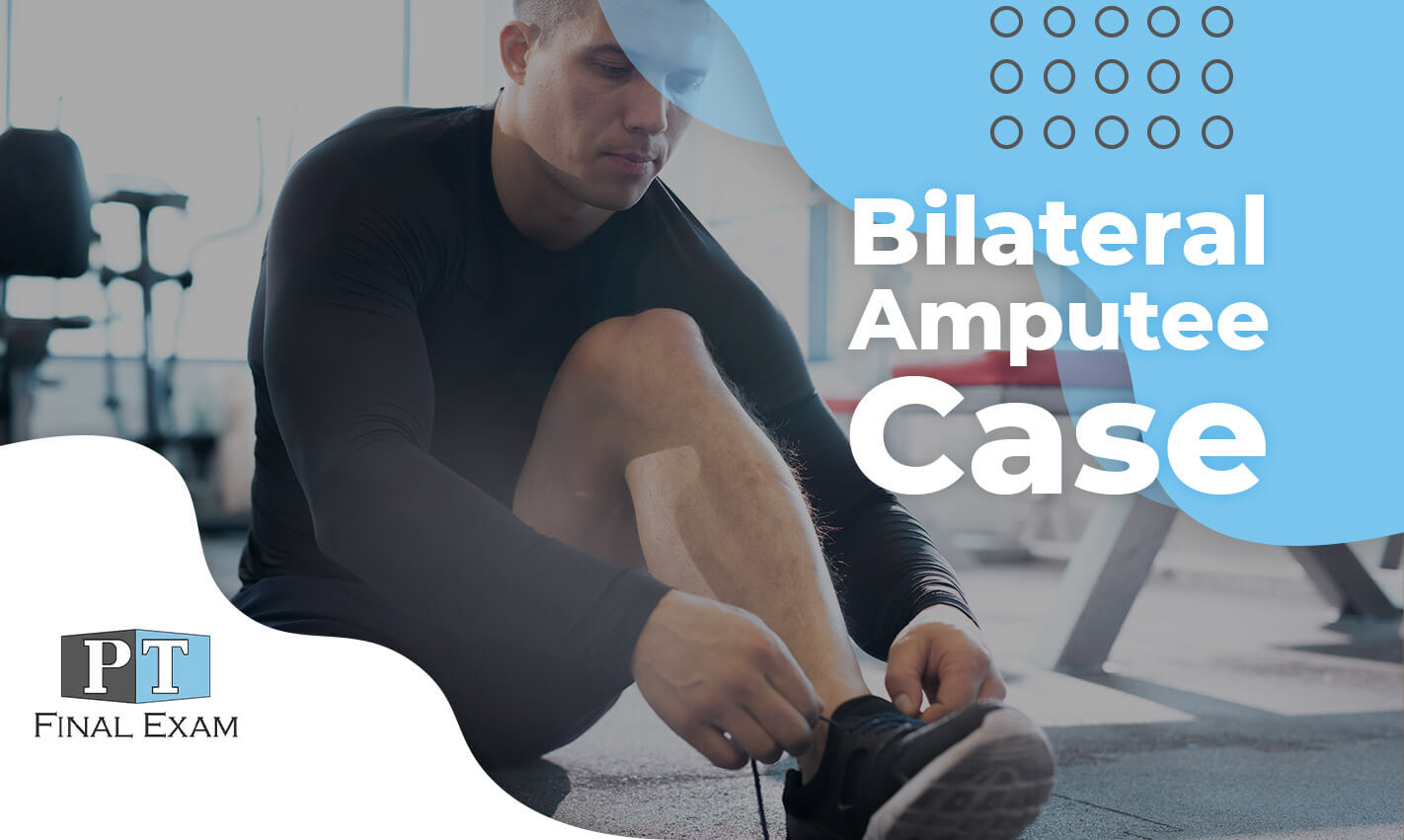 Another very interesting case I’ve seen in recent weeks is a patient with bilateral LE amputations.
Another very interesting case I’ve seen in recent weeks is a patient with bilateral LE amputations.
This particular woman has a number of complicating factors which make treatment pretty interesting. She consented to have a few of her details shared for this case study. I’ll list just a few of them:
Musculoskeletal:
It’s obvious, but the patient has an above-knee amputation (AKA) on the right and a below-knee amputation (BKA) on the left.
Her hands and upper extremities are also plagued with severe rheumatoid arthritis (RA). This makes donning and doffing the prosthetics incredibly difficult.
Cardiovascular:
The amputations are a result of peripheral artery disease (PAD) which caused progressive degeneration of both lower extremities. She had a total knee replacement (TKA) on the right, forcing her to have an AKA. The surgeon reported that he would not give her a BKA with a TKA in place.
Don’t you love the alphabet soup?
Integumentary:
The patient has decreased circulation in her residual limbs, making her skin extremely fragile. If any wound, bruise, or issue appears on the ends of the residual limbs, it requires a significant amount of time to heal.
Psychosocial:
The patient is unable to work and requires assistance for most transfers up or down. Financial constraints limit her participation in therapy.
Here are a few videos I shot of a recent treatment session. The patient agreed to be on camera to help clinicians learn how to deal with a case with multiple complications.
This video shows how difficult it is to don the sleeve holding the pin. This is the suspension system for the prosthetic.
This video shows the patient attempting to stand and walk. She was so anxious to stand that we didn’t get the gait belt on quick enough. We did keep the wheelchair extremely close for safety considerations.
A few follow-up questions—Would you know what to do?
How long would your treatment sessions last?
What would you give her as an HEP, considering that she cannot don the prosthetics independently?
The patient has bilateral hip flexion contractures and a left knee flexion contracture. What would you recommend?
What is the prognosis? Best case? Worst case?
What major issues would you watch for after a treatment session?
Would you know where to start?
These are all great questions to ask yourself. As a new therapist, I honestly felt a little lost when I first treated her. I now know at least a few of the most important things I would do to promote improved function while keeping the patient safe.
This is a good exercise to prepare yourself for the multiple choice questions on the NPTE. Be sure to check out some of my other case studies.
As always, I’d love to know what you think. Would you know what to do?


10 thoughts on “Bilateral Amputee Case”
Hey Will, I appreciate the case study. Just an FYI, “stumps” are no longer the accepted term. The amputations should now be called “residual limb(s).” Just wanted to let you
know.
Thank you! I changed it to reflect the proper terminology.
hey will, i love this case…
first of all i will focus on B/L hip contracture which will improved by streching of hip position , (prone, hip flx strect) and lt knee flexors stercthing ex…
for hand i will give her spints….in w/c i will give her post pelvic tilting form wedge,
prognosis..its hard to tell bcos she has healing as well as sensory loss over stump…and PAD… which also affected on prognosis….
let me know…..if i m worng in any points here….
Thanks for the case.
Firstly considering the age of the patient ,the number of co-morbities the patient’s prognosis looks poor.Number of Treatment sessions is hard to tell.
It is also important to know what are the functional goals of the patient, when was the amputation done and at what stage of healing is the site of the amputation.
Considering her current status, it is important to help her with
Positioning (especially prone) for some time to stretch the contracture. and also prevent pressure sores.
Advice her on frequent position changes.especially while lying on bed.
Training her with bed mobility.
low load long duration stretches for the hip contracture.
Making her independent in use of the prosthesis.
Train Static balance.
Upper extremity(UE) strengthening to help with use of assisted devices for balance.
Improve her cardiovascular status with UE ergometer.
Check her respiratory status.Teaching her breathing exercises.
Teach her ways to maintain skin integrity especially residual areas.Teach her or family members to inspect for any drainage or color changes.
Also frequent motivation to help her cope better.
Will…thanks for this case…wow, a lot of things going on. Well, I will start with patient education utilizing technique that pt best understands such as demonstration, using pictures, repetition and simple verbal terminology for communication purposes. Next, I will break the tasks down prior initiating the full functional task. For example: laying prone as tolerated with gradual increase in the time, include AROM with emphasis on strengthening B hip extensors, B hip abductors, stretching left hamstrings, utilizing moist heat to increase connective tissue elasticity and improve left knee extension and adding it up to improve sit to stand transfer. Her total treatment session time might need to be divided into several sessions because of greater energy expenditure with attempts to perform functional task. So, the session should be specific and direct due to time constraint. For example: have pt perform 50% don/doff and then move on and focus on one functional task of the day. Also, 10 minutes should be spent on laying prone along with exercises in that position such as hip abduction, hip extension, utilize gravity to promote left knee extension. This pt prognosis is poor and she requires 24hrs care at this time. I believe a great factor in her POC is psychosocial aspect, so pt requires social support and needs motivation in order to understand that life with prosthesis can be functional again. Please respond back with your thoughts. Thanks Will.
Hi! As a new grad I feel I have had a larger than normal exposure to amputees due to my current work setting.
After focusing on stretching for hip contractors and knee extension, my main focus within the parallel bars would be pre-gait exercises. She is having difficulty shifting her weight from side to side and maintaining hip extension in stance. Some activities would be static weight shifting, tap ups onto 4″ block, reaching activities to promote weigh shifting, use of a bolster over // bars to promote upright posture and hip extension, etc.
Pre-gait exercises help to break down each part of gait and then ending with ambulation (part practice to whole practice).
Great case to learn for the NPT!
Thanks for the case study.
Sessions I predict would last maybe 1-2 hours.
1. Physical exam and skin assessment
2. Instruction/training on prosthesis donning/doffing to the patient and family members, and use of elastic socks/removable rigid dressing for edema control, modulate pain
3. Patient education on positioning of residual limbs to prevent flexion and abduction contractures. Also begin bed mobility and transfer training
4. Start WB exercises between parallel bars progress to ambulation training
5. Strengthen hip and knee extensors, hip adductors
6. Condition UE extremity muscles give emphasis on wrist extensors elbow extensors scapular stabilizers
Considering her age wheelchair training would be better than crutch training. Overall prognosis should be fair with proper training and rehab. Worst case scenario is if she has PAD in her thigh as well and her residual limb isn’t healing because of edematous compression and causing pain. Psychological factors are also a huge factor when it comes to her participation and motivation to get better
What happen with the videos? I can’t see them.
Hello Will,
would you please comment on the question when the bilateral amputee with right transtibial and left transfemoral prosthesis is walking up and down the steps, which leg should be a leading leg?
Thank you
Jore
What are her Thomas test findings. It looks like she is beyond 30 degrees on her left – would be contraindicated for fitting a prosthesis!!. What is her knee contracture findings. How will she go into stance on transtibial side?? without falling?? – her quadriceps she would have to be amazingly strong at that angle? This makes me sad for her. Absolutely MUST work out the contractures. She is lovely but likely will become very discouraged with trying to walk and she will become inactive as her legs SIT in the closet.
Comments are closed.